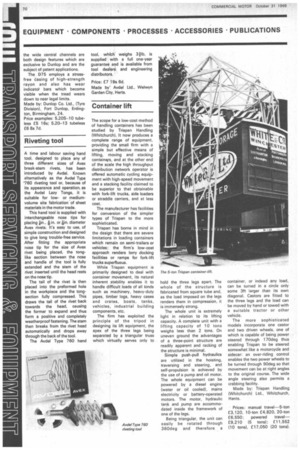Container lift
Page 72

If you've noticed an error in this article please click here to report it so we can fix it.
The scope for a low-cost method of handling containers has been studied by Trispan Handling 1Whitchurchl. It now produces a complete range of equipment, providing the small firm with a simple but effective means of lifting, moving and stacking containe,,rs, and at the other end of the scale the high throughput distribution network operator is offered automatic cycling equipment with high-speed movement and a stacking facility claimed to be superior to that obtainable with fork-lift trucks, side loaders or straddle carriers, and at less cost.
The manufacturer has facilities for conversion of the simpler types of Trispan to the more sophisticated.
Trispan has borne in mind in the design that there are severe limitations in loading containers which remain on semi-trailers or vehicles: the firm's low-cost approach renders lorry docking facilities or ramps for fork-lift trucks superfluous.
While Trispan equipment is primarily designed to deal with container movement, its natural inherent stability enables it to handle difficult loads of all kinds such as machinery, heavy-duty pipes, timber logs, heavy cases and crates, boats, tanks, vehicles, industrial building components, etc.
The firm has exploited the principle of the tripod in designing its lift equipment, the apex of the three legs being separated by a triangular truss which virtually serves only to hold the three legs apart. The whole of the structure is fabricated from square tube and, as the load imposed on the legs renders them in compression, it is immensely strong.
The whole unit is extremely light in relation to its lifting capacity. A complete unit with a lifting capacity of 10 tons weighs less than 2 tons. On uneven ground the advantages of a three-point structure are readily apparent and racking of the structure is minimal.
Simple push-pull hydraulics are utilized in the hoisting, traversing and steering, and self-propulsion is achieved by the use of a pump and oil motor. The whole equipment can be powered by a diesel engine (water or oil cooled), mains electricity or battery-operated motors. The motor, hydraulic tank and pump are accommodated inside the framework of one of the legs.
Being triangular, the unit can easily be rotated through 360deg and therefore a container, or indeed any load, can be turned in a circle only some 3ft larger than its own diagonal. Castors are fitted to the three legs and the load can be moved by hand or towed with a suitable tractor or other vehicle.
The more sophisticated models incorporate one castor and two driven wheels, one of which is capable of being power steered through 170deg thus enabling Trispan to be steered somewhat like a motorcycle and sidecar: an over-riding control enables the two power wheels to be turned through 90deg so that movement can be at right angles to the original course. The wide angle steering also permits a crabbing facility.
Made by: Trispan Handling (Whitchurch) Ltd., Whitchurch, Hants.
Prices: manual travel-5-ton £3,120. 10-ton £4.820, 20-ton £6.550; powered travel— £9,210 (5 tons): £11,552 (10 tons), £17,050 (20 tons).


























































































































